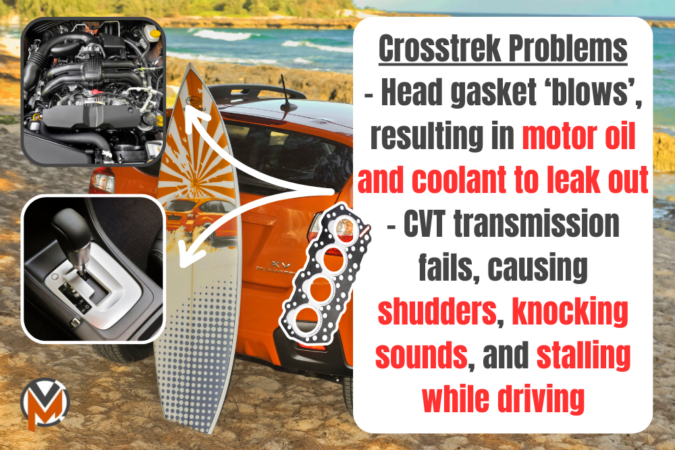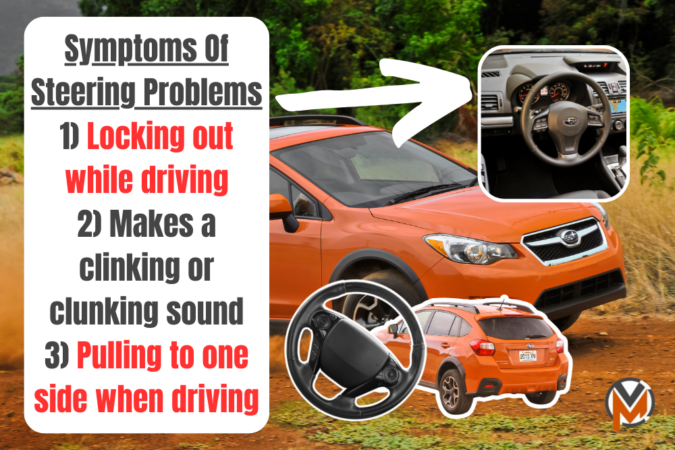The Subaru Crosstrek is a hugely popular compact SUV known for its reliability, off-road capabilities, and solid reputation. However, like any vehicle, the Subaru Crosstrek is not without problems, with common faults ranging from head gasket failures to CVT transmission issues, as well as excessive oil consumption, and plenty more.
These problems can be quite costly and troublesome if not addressed promptly. With this in mind, we’ll be taking a closer look at the many Subaru Crosstrek problems that you need to look out for, as well as the early signs of failure and symptoms to be wary of. Plus, we’ll also look at the respective repair costs, and some preventive maintenance tips.
On the bright side, continuous improvements and gradual evolution have made the Crosstrek a pretty reliable option nowadays. For reference, while we’ll be discussing each problem in way more detail further below, here’s a quick TL;DR of the common Subaru Crosstrek problems that you’ll have to watch out for:
- Head gasket failure
- CVT transmission failure
- High motor oil consumption
- Faulty PCV valves
- Rodent infestation of the wiring
- Subaru Eyesight failure
- Steering problems
- Cracking windshields
Subaru Crosstrek Reliability
If you’re looking to get a used Subaru Crosstrek, here are some of the most common Subaru Crosstrek problems that you need to look out for:
Subaru Crosstrek Problems #1 – (Blown) Head Gasket Failure
This is by far the most common of all Subaru Crosstrek problems: the head gaskets. In fact, faulty head gaskets are one issue that many Subaru models face, despite their reputation for being generally reliable. This head gasket issue is more prevalent on the larger 2.5-liter engine. The head gasket is responsible for proper motor oil and coolant flow.
When the head gasket “blows”, motor oil and coolant can leak out, thus overheating the engine and damaging the internals. As you can imagine, this is pretty damaging, and replacing the head gasket involves disassembling most of the engine. If the head gasket does blow, among the symptoms you’ll experience is likely to be engine overheating.
Otherwise, you might also notice white smoke coming out of your exhaust. If and when you do notice these symptoms, it’s vital to be diligent and get this fixed ASAP. Otherwise, continuing to drive with a worn head gasket could end up mortally damaging the engine. Unfortunately, the cost of replacing the head gasket, given its complexity, is pretty costly.
A head gasket replacement can cost upwards of $1,500 just for labor alone. The parts cost will add another $1,100 to $1,200 just for the gasket and an additional $700 for other associated parts. Nevertheless, this is way cheaper than having to replace your Crosstrek’s entire engine, which is what would happen if you ignore a head gasket failure.
Symptoms, Fixes, And Maintenance
The head gasket seals your engine block and the cylinder head, maintaining proper oil and coolant circulation. A blown head gasket can lead to symptoms appearing, such as:
- Engine overheating due to coolant leaks.
- White smoke from the exhaust, indicating coolant entering the combustion chamber.
- Oil contamination, which leads to reduced lubrication and causes internal engine damage.
If your Subaru Crosstrek’s head gasket fails, the only real solution is to replace it. This is a labor-intensive job requiring significant engine disassembly. Costs for this repair include:
- Labor – $1,500 or more.
- Parts – $1,100 to $1,200 for the gasket, plus $700 for associated components.
Ignoring this issue can lead to catastrophic engine damage, making a full engine replacement necessary. So, it’s not a bad idea to ignore a blown head gasket.
On the bright side, here are some preventive maintenance tips to reduce the risks of this issue appearing too often:
- Regularly check for oil or coolant leaks.
- Maintain your cooling system by flushing coolant at recommended intervals.
- Never drive with an overheating engine—pull over and investigate immediately.
Subaru Crosstrek Problems #2 – CVT Transmission Failure
In 2018, Subaru announced a warranty extension program for its Continuously Variable Transmissions (CVTs), including the one used in the Crosstrek. This hiked the warranty for the transmission from the original 5 years or 50,000 miles to 10 years or 100,000 miles, whichever comes first. This extension applied to almost all of their models in the US.
That includes the Crosstrek, Legacy, Forester, Impreza, WRX, and Outback. Subaru claims that there were no customer complaints or concerns raised against the CVT. The warranty extension was more of an added assurance about the reliability of the CVT, they reported. However, customers had a different story, detailing countless issues with Subaru’s CVT.
According to Subarucomplaints.com, almost 1,500 individual complaints were logged and reported a connection with this issue. Customers experienced odd shudders and vibrations, stalling or their cars dying out while driving, and knocks from the CVT. In short, the CVT started to give a jarring ride, a few years into the life of the vehicle.
Under this extended warranty for Subaru’s CVT transmission, customers could get free repair and replacement of parts if they were facing problems with their CVTs. Dealers conducted free inspections even for vehicles that did not have any symptoms. Otherwise, if you had to pay out of pocket, a brand-new transmission from Subaru would cost $7,000 to $8,000.
Symptoms, Fixes, And Maintenance
While Subaru extended the CVT warranty to 10 years/100,000 miles, numerous complaints have surfaced, including early signs of failure, such as:
- Shuddering and vibrations, particularly when accelerating.
- Unexpected stalling or loss of power while driving.
- Jerky shifts and hesitation, reducing smoothness and reliability.
If your Crosstrek experiences CVT problems, Subaru’s extended warranty may cover the repairs. Otherwise, repair costs can be substantial, including:
- Transmission replacement – $7,000 to $8,000.
- Fluid change and minor repairs – $300 to $800, depending on the issue.
Thankfully, there are preventive maintenance tips to reduce the chances of transmission problems appearing:
- Regularly change the CVT fluid (even though Subaru claims it’s “lifetime”).
- Avoid aggressive acceleration and sudden stops to reduce strain.
- If you notice hesitation or shuddering, get the transmission inspected early.
Subaru Crosstrek Problems #3 – Excessive Motor Oil Consumption
This is yet another one of the many Subaru Crosstrek problems that were shared with its sister models. Many Subarus, including the Crosstrek, particularly from the model years 2012 to 2015, were found to have consumed more oil than it is used to. This is among a litany of other Subaru oil consumption issues. Part of this was due to the head gasket issue from earlier.
However, besides the faulty head gasket design, the excessive oil consumption problem was attributed to other causes, too. Subaru dealers were forced to replace pistons and oil rings to bring this issue under control. However, this was found to be only a temporary stop-gap measure. As such, they later decided to replace the entire short block assembly to fix this for good.
Symptoms, Fixes, And Maintenance
Many Subaru models, including the Crosstrek (especially 2012-2015 models), are known to consume oil at an excessive rate. Some potential causes of this issue include:
- Defective piston rings, leading to oil burning.
- Head gasket issues, which allow oil to mix with coolant.
- PCV valve failure, which can send excess oil into the combustion chamber.
Subaru has offered short-block engine replacements for severe cases, but not all vehicles qualify. For minor cases, fixes that you might consider include:
- Replacing piston rings (~$1,500 – $2,500).
- Regularly checking oil levels and topping up when necessary.
If you’d like to reduce the chances of this problem appearing too often (or at all), here’s some preventive maintenance that you can do:
- Check your oil level frequently—at least once a month.
- Use Subaru-approved oil to minimize burning.
- If you notice blue smoke from the exhaust, have the engine inspected.
Subaru Crosstrek Problems #4 – Faulty PCV Valves
Out of all the common Subaru Crosstrek problems that we mentioned thus far, this one is among the more recent to be found, affecting the second-generation Crosstrek, built after 2018. In particular, the PCV valves were found to be flawed. It keeps the waste gases from building up inside the crankcase. It thus lets gases escape back into the intake system for reuse.
But, with the Crosstrek, the PCV valve can go wrong. If the PCV valve fails, motor oil may enter the combustion chamber. It could get worse, as the parts of a PCV valve can also fall into the engine, damaging the internals. A recall was issued for this problem, covering the costs of replacement. Subaru also offered to cover the cost of replacing the engine.
Symptoms, Fixes, And Maintenance
The PCV (Positive Crankcase Ventilation) valve helps manage engine gases, but some 2018+ Crosstrek models had defective PCV valves that cause symptoms to appear, such as:
- Allowed oil into the combustion chamber, leading to excessive oil consumption.
- Broke apart, with plastic fragments potentially damaging the engine.
Subaru did issue a recall for affected models, offering:
- Free PCV valve replacements at select dealerships.
- Engine replacement coverage for vehicles with severe internal damage.
Moreover, you can practice preventive maintenance to reduce the risk of this problem affecting your car:
- Check Subaru’s recall list to see if your Crosstrek is affected.
- Replace the PCV valve at regular service intervals.
- Look for signs of excessive oil consumption or blue exhaust smoke.
Subaru Crosstrek Problems #5 – Rodent Infestation On The Wiring
Subaru, in a bid to be as eco-friendly as possible, swapped some of the synthetic plastic electrical wire coatings with greener material. This bio-degradable soy-based coating was great for nature as it reduced the synthetic waste going to landfills. It was also cheaper, helping Subaru save money. However, this had an unintentional side-effect: rodent attacks!
In the eyes of a rat or most other rodents, all those soy-based wiring and cables were large chew toys nestled in a dark, safe environment warmed up by an engine after a drive. Rat heaven maybe. The soy-based wires were chewed on by rodents, leading to electrical issues. Many owners woke up to severed fuel lines or torn-out wiring harnesses.
To be fair, Subaru was not the only manufacturer caught in this mess. Along with Subaru Toyota, Honda, Hyundai, and Kia had lawsuits filed against them. Pretty much most other carmakers adopted the use of soy-based wiring. Owners were also enraged to find out that their warranty did not cover this damage, and the repair bills were pretty significant.
Symptoms, Fixes, And Maintenance
Subaru’s soy-based wiring insulation, introduced as an eco-friendly initiative, has an unintended downside—it attracts rodents. This can lead to problems such as:
- Chewed electrical wires, causing short circuits.
- Damaged fuel lines, leading to leaks.
- Malfunctioning sensors and warning lights due to disrupted electrical signals.
Fixing chewed-up wires isn’t cheap, so here’s what you need to prepare for:
- Repair damaged wiring, which can cost anywhere from $500 to $2,000 depending on the extent of damage.
- Install rodent deterrents, such as tape infused with capsaicin (spicy pepper extract) to prevent chewing.
To prevent rodents from chewing up your Subaru Crosstrek’s wires, here are some things you could do:
- Park indoors when possible.
- Use rodent repellents or electronic deterrents in your garage.
- Check under the hood for signs of nesting or chew marks.
Subaru Crosstrek Problems #6 – Failure Of Subaru Eyesight
Subaru Eyesight is a suite of driver-assist technologies that helps improve safety. It includes active safety systems pre-collision automatic braking, lane-departure alerts, collision warning, and adaptive cruise control. Unfortunately, Subaru’s Eyesight, particularly some of its earlier iterations, wasn’t particularly precise and could be easily distracted.
In fact, Subaru’s Eyesight system could easily be hindered by fog, water spray, and other environmental conditions. To make matters worse, it used monochrome cameras in its earlier versions. This made it difficult for it to spot and recognize brake lights. Thankfully, Subaru swapped it out for color cameras starting in 2015.
Symptoms, Fixes, And Maintenance
Subaru’s EyeSight safety system includes features like adaptive cruise control, lane departure warning, and pre-collision braking. However, early versions struggled with problems such as:
- Poor visibility in fog and rain.
- Difficulty detecting brake lights.
- False alerts and unnecessary braking.
There’s not much that you can do to fix this yourself, but here are some solutions that you might consider:
- 2015+ models received color cameras, which improved reliability.
- Software updates from Subaru dealers can address certain issues.
Elsewhere, there are actually some maintenance techniques and tips to keep Subaru’s Eyesight system functioning reliably:
- Keep the cameras clean and free from obstructions.
- Update the Eyesight software when available.
- Be aware of system limitations—don’t rely on it in poor weather.
Subaru Crosstrek Problems #7 – Steering Issues
The next problem with the Subaru Crosstrek is associated with the car’s steering. Mainly found in the 2016 Subaru Crosstrek, this problem can be a pain to live with. The steering of these vehicles reportedly gets locked while driving, or it makes a clicking or clunking noise when turning at full lock. As you can imagine, this is both unsafe and dangerous.
Your Subaru Crosstrek, if it was impacted by these steering problems, may pull to one side while driving. This one is particularly frustrating among the Subaru Crosstrek problems. However, it would not be a massive headache to fix, at least compared to some of the other issues mentioned above. Still, it’s worth bearing this in mind if you’re getting one.
Symptoms, Fixes, And Maintenance
Some Crosstrek models, especially the 2016 models, have reported steering problems such as:
- Steering wheel locks up while driving.
- Clicking or clunking noises when turning.
- Pulling to one side.
Fixing these Subaru Crosstrek steering problems won’t be cheap, so you’ll have to prepare for:
- Steering rack replacement – $1,200 – $2,000.
- Power steering fluid flush – $100 – $150.
To prevent steering problems from cropping up frequently, it’s a good idea to:
- Check steering fluid regularly.
- Address any unusual noises or stiffness immediately.
Subaru Crosstrek Problems #8 – Cracking Windshield
Many reports by owners of Subaru Crosstreks of their windshields cracking have been reported. Oftentimes, these reports were made of their windshield cracking without even an impact. The crack may also spread rapidly across the rest of the windshield. Obviously, the only proper and permanent fix for this issue is to replace the windshield.
Or, if the chips and cracks aren’t significant, you could also get away with repairing the chips or cracks using a DIY repair kit. This particular problem, however, is not rampant or severely fundamental with the Subaru Crosstrek as a whole. Only a few vehicles are found to have developed this issue, but it’s worthwhile taking notes if you’re planning to buy one.
Some owners have even reported cracks forming spontaneously, even without impact. Subaru has since faced lawsuits over this windshield problem, particularly for the 2015-2020 models. If your Crosstrek is affected, make sure to check for any recalls or warranty coverage. This way, you won’t have to pay for repairs out-of-pocket.
Symptoms, Fixes, And Maintenance
Some Subaru Crosstrek owners have reported spontaneous windshield cracks, often occurring without an obvious impact. The problem has been linked to underlying issues such as:
- Weak or defective glass, which is prone to stress fractures.
- Windshield defroster heat variations, which can cause sudden expansion and cracking.
- Thin glass design, especially in post-2018 models.
Subaru faced a class-action lawsuit over similar windshield issues in other models, but not all Crosstreks were covered. If so, then you’ll have to fix this issue yourself, which might entail:
- Windshield replacement ($500 – $1,200 depending on OEM vs. aftermarket glass).
- Subaru warranty claims—check if your model qualifies for coverage.
- Using a windshield protection film to add an extra layer of durability.
Plus, there are some things you could do to try and prevent your windshield from cracking:
- Avoid sudden temperature changes (e.g., blasting the defroster on a frozen windshield).
- Park in shaded areas to reduce heat-related expansion and contraction.
- Address small chips immediately before they spread into full cracks.



